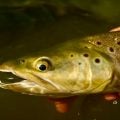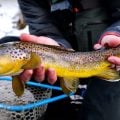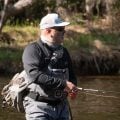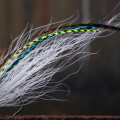How to Cast Heavy Flies Without Getting Hurt or Humbled

Image by Dan Favato
There’s no graceful poetry in casting musky streamers, deer hair divers, or triple-jointed monstrosities that resemble something coughed up by a raccoon. These aren’t flies—they’re payloads. And unless the angler makes a few key adjustments, these payloads can feel more like projectiles than flies.
Casting big bugs on a fly rod isn’t about elegance. It’s about control, intention, and knowing when to let the rod—and the line—do the heavy lifting.
Start with the Right Gear, or Don’t Bother
A 4-weight rod won’t cut it here. For bass bugs, a 7- to 9-weight rod offers enough backbone. For musky and pike, 10- or 11-weight sticks are standard. Forget distance and finesse—the job is to deliver junk with authority.
The fly line does the heavy work. Use a short, aggressive taper line designed to turn over meat—lines like the SA Titan, Rio Predator, or Airflo Musky/Pike. These lines carry mass up front, which is crucial for propelling flies that move more air than a goose decoy.
Leaders should be short and stout. Think 3 to 5 feet of 20–40 lb mono or fluoro. Toothier fish call for a wire bite tippet. Skip the elegant tapers. With heavy flies, long leaders act more like bungee cords than delivery systems.
Open It Up: Adjust the Cast
Forget everything learned on trout water. Tailing loops and tight, sexy casts are a recipe for disaster when casting a fly with the aerodynamics of a badminton birdie.
Belgian Cast: The Workhorse
Use a Belgian (or oval) cast—low on the backcast, high on the forward stroke. This continuous motion keeps the fly moving, reduces slack, and most importantly, keeps it out of your hat. It’s less a cast and more a controlled sling.
Widen the Stroke, Open the Loop
Tight loops don’t play nice with bushy flies. Open the stroke. Let the loop breathe. The key is smooth acceleration to a hard stop—both fore and aft—without trying to force distance. Power comes from line speed, not muscle.
Double Haul, Every Time
Even with a fast rod and proper line, a good double haul is non-negotiable. It loads the rod, increases speed, and helps straighten the leader on the delivery. Practice the haul until it’s second nature. With heavy flies, it’s the difference between a clean cast and a slap-to-the-back-of-the-neck surprise.
Wind, Angles, and Safety
Always wear glasses. Always. And keep a hat on. Heavy hooks driven by fly lines can puncture skin, crack lenses, and end fishing days fast.
Check wind direction before every cast. If the breeze is blowing into the casting shoulder, switch shoulders or turn the boat. Anglers who ignore the wind end up with stories they’d rather not tell.
Special Techniques: On Water and in Boats
Water-Load Casts
Let the fly hang in the water behind on the pickup. Use that tension for a water-loaded roll into a backcast. It’s safer, smoother, and reduces slack when lifting a soaked, heavy streamer.
Short-Angled Deliveries from the Boat
In boats, cast at angles—never directly sideways. A slightly off-bow cast gives more room for the backcast and keeps the fly in sight. When figure-eighting at boatside, keep movements short, controlled, and deliberate. This isn’t ballet—it’s close-quarters combat.
Train for the Grind
Throwing big bugs all day is a workout. Rotator cuffs don’t last forever. Strengthen shoulders, stretch regularly, and use proper form. Good casting isn’t about brute force—it’s about repeatable motion.
Final Word
Casting heavy flies isn’t complicated, but it is different. It requires unlearning some habits and learning others. The anglers who stick with it—who respect the gear, study the cast, and adapt to conditions—soon find that these big, ugly flies start turning into big, beautiful fish.











